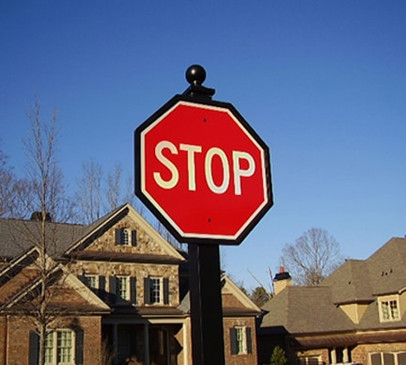Atlanta Stop Sign Experts
Posted by Thomas on Jul 10th 2014
The History of Stop Signs Many of the street signs that we see today are simply taken for granted as part of our daily lives. Yet the stop sign has not always been the same as it is today. In fact, the stop sign has undergone an evolutionary process over the past century which has led to its current appearance. There are currently rules and regulations for stop sign installation, appearance and where they may be located down to the inch. There is also a uniformity that exists today that was not present at first, so Atlanta stop signs look the same as Seattle stop signs and so forth to avoid any confusion. What follows is the history of stop signs and how they have evolved over the years into what we see on a daily basis. The Origins of Stop Signs The first stop sign in the US appeared in Michigan in 1915. As typical of the first stop signs, it had a white background with black lettering and was somewhat smaller than the current stop signs we see today. As stop signs began appearing around the country, the American Association of State Highway Officials formed a committee in 1922 to standardize them to reduce confusion. The result was an octagonal stop sign that is still in use today. The reason why the octagonal shape was chosen was to help drivers identify a stop sign while coming from the opposite direction and it was unlike the shape of any other traffic sign. Plus, since stop signs had no reflective coating in those days, the octagon shape was easier to spot at night. From its initial work, the organizations that were in charge of creating the standards for stop signs joined together to form the Joint Committee on Uniform Traffic Control Devices and created the first Manual on Uniform Traffic Control Devices (MUTCD) in 1935. The Big Changes in the 1950s & 1970s From 1925 to 1954, stop signs were octagonal and featured black lettering on a yellow background. Plus, they were often positioned two to three feet above the ground. However, the MUTCD specifications were changed in 1954 to the white lettering on the red background that we see today. While there was concern that the changes would cause confusion, the use of the color red was backed up by the red colored stop lights that were present at the time. In 1971, the last major change was made to stop signs which were their elevation to 7’ above the ground. Until then, stop sign installation was typically 2’ to 3’ from the surface which was roughly eye level to the driver. By elevating them to 7’, the stop signs could be seen at a much further distance. Today, wherever you travel around the country, you’ll see same type of Los Angeles stop signs as Atlanta stop signs as Miami stop signs and so forth. The uniformity of the stop sign lowers any confusion and brings about greater traffic safety thanks to the efforts of the Joint Committee on Uniform Traffic Control Devices and their regulations which helps keep all of us safe.

